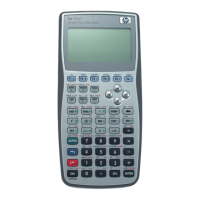Full Command and Function Reference 3-37
COV
Type: Command
Description: Covariance Command: Returns the sample covariance of the independent and dependent data
columns in the current statistics matrix (reserved variable ΣDAT).
The columns are specified by the first two elements in reserved variable ΣPAR, set by XCOL
and YCOL respectively. If ΣPAR does not exist, COV creates it and sets the elements to their
default values (1 and 2).
The covariance is calculated with the following formula:
1
n 1–
------------
x
in
1
x
n
1
–()x
in
2
x
n
2
–()
i 1=
n
∑
where is the ith coordinate value in column n
1
, is the ith coordinate value in the column
n
2
, is the mean of the data in column n
1
, is the mean of the data in column n
2
, and n is
the number of data points.
Access: …µ
COV
Input/Output:
Level 1/Argument 1 Level 1/Item 1
→
x
covariance
See also: COLΣ, CORR, PCOV, PREDX, PREDY, XCOL, YCOL
CR
Type: Command
Description: Carriage Right Command: Prints the contents, if any, of the printer buffer.
CR sends to the printer a string that encodes the line termination method. The default
termination method is carriage-return/linefeed. The string is the fourth parameter in the reserved
variable PRTPAR.
Access: …µ
CR
Flags: I/O Device (–33), Printing Device (–34), Double-Spaced Printing (–37)
Input/Output: None
See also: DELAY, OLDPRT, PRLCD, PRST, PRSTC, PRVAR, PR1
CRDIR
Type: Command
Description: Create Directory Command: Creates an empty subdirectory with the specified name in the
current directory.
CRDIR does not change the current directory; evaluate the name of the new subdirectory to
make it the current directory.
Access: !°
MEMORY DIRECTORY CRDIR ( °is the left-shift of the Nkey).
Input/Output:
Level 1/Argument 1 Level 1/Item 1
'global'
→
See also: HOME, PATH, PGDIR, UPDIR
CROSS
Type: Command
Description: Cross Product Command: CROSS returns the cross product C = A
× B of vectors A and B.
The arguments must be vectors having two or three elements, and need not have the same
number of elements. (The hp49g+/hp48gII automatically converts a two-element argument
in
1
in
2
n
1
n
2

